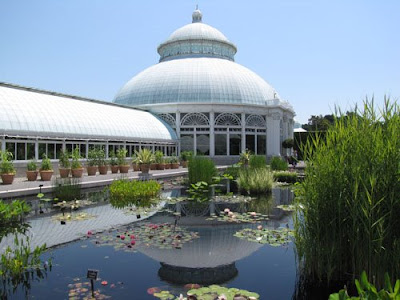
Pots of tomatoes, peppers, corn, squash and other vegetables line the waterlily pool at the Enid A. Haupt Conservatory at the NYBG.
It seems like I've been growing vegetables and herbs in pots for ages, albeit on a much less grand scale than the NYBG. I love having tomatoes nearby so I can brush up against the fragrant foliage (if someone could bottle the scent of tomato foliage I'd buy it by the boatload); having mint in a pot on the deck makes it easy to add a sprig to my iced tea; and eggplants are just pretty plants. Period. Whether or not we actually get any eggplants. And I always have at least one big pot of flat-leaf parsley on the deck out of reach of the deer.
Growing veggies and herbs in pots is easy. I use mostly recycled black nursery containers -- it helps unify the look on a deck or patio -- and potting mix that we buy by the bale. Find a sunny location. Pay attention to water -- the pots often will need to be watered every day depending on the weather. I use a liquid fertilizer about once a week. I also like to mix in a few flowers, often planting lobelia or alyssum as a ruffle around the edge of the pot.

























